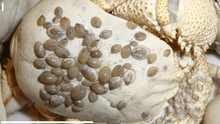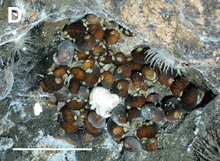Lepetodrilus sp. East Scotia Ridge
| Lepetodrilus sp. East Scotia Ridge | |
|---|---|
 | |
| Lepetodrilus sp. from East Scotia Ridge on carapace of large individual of Kiwa sp. | |
| Scientific classification | |
| Kingdom: | Animalia |
| Phylum: | Mollusca |
| Class: | Gastropoda |
| (unranked): | clade Vetigastropoda |
| Superfamily: | Lepetodriloidea |
| Family: | Lepetodrilidae |
| Genus: | Lepetodrilus |
| Species: | L. sp. East Scotia Ridge |
| Binomial name | |
| Lepetodrilus sp. East Scotia Ridge | |
Lepetodrilus sp. East Scotia Ridge (nomen nudum) is an as yet undescribed species of small, deep-sea sea snail, a hydrothermal vent limpet, a marine gastropod mollusk in the family Lepetodrilidae.
The first information about this species, under the name "Lepetodrilus n. sp.", was published on 3 January 2012.[1]

Distribution
This species is known from two sites near hydrothermal vents in the East Scotia Ridge: from 2,394 m depth at the E9 vent site, and from 2,608 m depth at the E2 site.[1]
Description
Phylogenetic analysis of the mitochondrial cytochrome-c oxidase I (COI) gene of this limpet (GenBank accession number JN628254) and a range of other Lepetodrilus species, using Bayesian inference, places this species from East Scotia Ridge as a sister taxon to Lepetodrilus atlanticus, with a sequence divergence from this species of 5.48%.[1] This level of genetic divergence is consistent with that found between Lepetodrilus species within complexes of sister taxa, where interspecific distances of between 3% and 15% have been observed.[1]
Ecology

This species is ubiquitous in low-temperature diffuse flow, being found on bare rock, sulphides, Kiwa sp., gastropods Gigantopelta chessoia, and stalked barnacles.[1] On the carapace of Kiwa n. sp., a "halo" of pale colouration surrounding the limpets indicates where this species of Lepetodrilus is grazing epizoic microbes.[1]
The population density of Lepetodrilus sp. on the barnacles Vulcanolepas scotiaensis was estimated to 20,172–56,904 individuals m−2.[2][3]
References
This article incorporates CC-BY-2.5 text from the reference[1]
- 1 2 3 4 5 6 7 Rogers A.D., Tyler P.A., Connelly D.P., Copley J.T., James R., Larter R.D., Linse K., Mills R.A., Garabato A.N., Pancost R.D., Pearce D.A., Polunin N.V., German C.R., Shank T., Boersch-Supan P.H., Alker B.J., Aquilina A., Bennett S.A., Clarke A., Dinley R.J., Graham A.G., Green D.R., Hawkes J.A., Hepburn L., Hilario A., Huvenne V.A., Marsh L., Ramirez-Llodra E., Reid W.D., Roterman C.N., Sweeting C.J., Thatje S. & Zwirglmaier K. (2012). "The Discovery of New Deep-Sea Hydrothermal Vent Communities in the Southern Ocean and Implications for Biogeography". PLoS Biology 10(1): e1001234. doi:10.1371/journal.pbio.1001234.
- ↑ Marsh L., Copley J. T., Huvenne V. A. I., Linse K., Reid W. D. K., Rogers A. D., Sweeting C. J. & Tyler P. A. (2012). "Microdistribution of faunal assemblages at deep-sea hydrothermal vents in the Southern Ocean". PLoS ONE 7: e48348. doi:10.1371/journal.pone.0048348
- ↑ Buckeridge J. S., Linse K. & Jackson J. A. (2013). "Vulcanolepas scotiaensis sp. nov., a new deep-sea scalpelliform barnacle (Eolepadidae: Neolepadinae) from hydrothermal vents in the Scotia Sea, Antarctica". Zootaxa 3745(5): 551-568. doi:10.11646/zootaxa.3745.5.4.